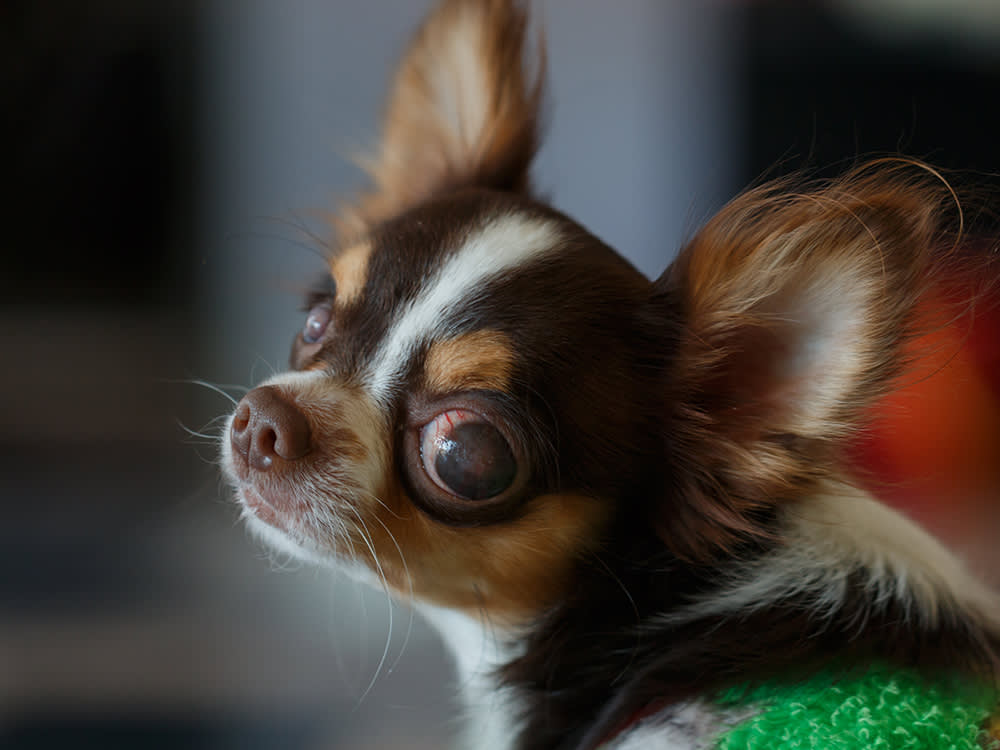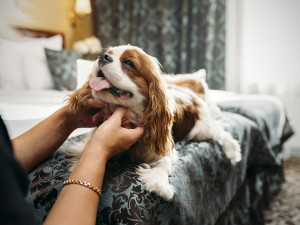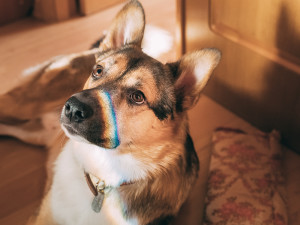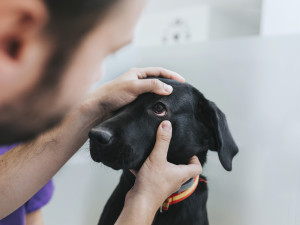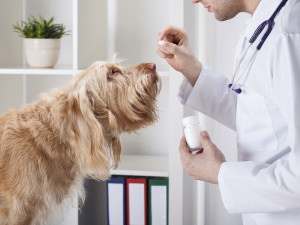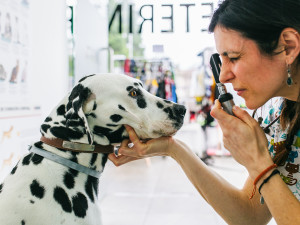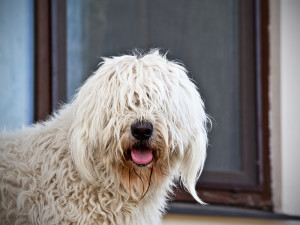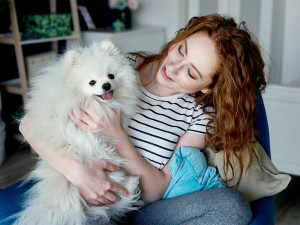Common Eye Problems in Dogs and How to Treat Them
Your dog sees you as their best friend, so keep those eyes healthy.
Dogs are susceptible to a variety of eye disorders, some of which can be serious and lead to vision loss. Eye diseases seen in dogs include conjunctivitis, dry eye, corneal ulcers, cataracts, glaucoma, and retinal disorders. Early detection and treatment are essential for the best outcome. If you notice any changes in your dog’s eyes, such as redness, swelling, discharge, squinting, or tearing, it is important to see a veterinarian right away.
“Puppy-dog eyes” get dog parents every time. It’s been proven that gazingopens in new tab into your pet’s eyes produces oxytocin and promotes bonding. They are the epitome of the “pleading face” emoji. Irresistible.
It could be something more than cuteness, though. If your dog’s eyes have been looking a little red or cloudy lately or if you’ve noticed they’re pawing at, rubbing, or showing signs of irritation around their eyes, you might need to make an appointment with your vet.
“As a general practitioner, I was often presented with problems such as conjunctivitis, dry eye, and corneal ulcer,” says Dr. Christine Lim, a veterinarian in Chicago. “Now that I specialize in ophthalmology, I more often see cataracts, glaucoma, and retinal disorders.”
What are the most common eye problems in dogs?
Eye problems in dogs are no joke — dogs can suffer from a host of health conditions including glaucoma, conjunctivitis, dry eyes, cataracts, and more. Some eye disorders occur more often than others and a dog’s breed usually plays a role in that. Common eye problems in dogs include:
Eye infections
Dry eye
Cataracts
Glaucoma
Corneal ulcers
Uveitis
Conjunctivitis
Watery eyes
Entropion/Ectropion
Bulging Eyes
Cherry eye
Lazy eye
Retinal Disorders
How dogs’ eyes work
To understand eye problems in dogs, it helps to know a little bit about how their eyes function. A dog’s eyes work much like a camera. Light first enters through the clear cornea then passes through the pupil. The iris controls the amount of light allowed in through the pupil. Next, light goes through the lens, which focuses the light on the retina — a layer containing color-sensitive cones and motion- and light-sensitive rods, which convert light into electrical signals. The cones and rods send these signals via the optic nerve to the brain, which constructs an image from them.
Dogs have only two types of cones, compared with the three types in human eyes. As a result, dogs don’t see as many colors as people do. Dog eyes also contain structures not found in a camera, such as the gel-like vitreous humor that fills the eyeball and gives it shape. Canine eyes are different from human eyes in that they have a third eyelid, called the nictitating membrane, which is a thin whitish-pink tissue that protects the eye. And unlike humans, dogs have a reflective lining behind the retina called the tapetum lucidum; it’s what makes dogs’ eyes glow eerily when light hits them. It’s also what allows them to see in dimmer light.
The visual streak is a horizontal band in the retina right above the optic nerve; this area has the highest concentration of rods and cones, and vision is sharpest here. The visual streak varies greatly among breeds, and studies suggest that different breeds see the world differently. In dogs with long heads like wolves, the streak is wide, with the nerves evenly distributed. The shorter a breed’s head, the narrower (more circular) the streak tends to be. Pugs, for example, have a small spot of sharp vision — an “area centralis” — like humans do. Even within breeds, the visual streak can vary from type to type.
How well do dogs see?
All of these features equip a dog to be a good hunter under various light conditions. The tapetum lucidum improves a dog’s vision in low light, as does the high proportion of rods to cones, giving dogs better vision at nightopens in new tab than humans. A rod-dense retina also makes dogs excellent at detecting motion and shapes. Because most dogs’ eyes angle slightly to the side, they have a wider field of view than humans. When a wide field of vision combines with a wide visual streak, as in a German Shepherd, a dog can see the whole horizon at once (instead of having to scan the eyes back and forth as humans do).
With keen senses of smell and hearing, dogs don’t need to see well up close; in fact, near vision is blurry in long-nosed dogs. Short-nosed dogs, with their human-like area centralis, do appear to see well up close. Though the area centralis may lessen their ability as hunters, it may make them better lap dogs, more able to “read” their parents’ faces. Overall, dog vision is less sharp than human vision.
What are the signs of eye problems in dogs?
Dog parents may be cued into an issue with their dog’s eye if it changes in appearance or if their dog seems to be experiencing eye irritation. Any concerns about a dog’s eyes should not be ignored. Signs of eye problems in dogs include:
Squinting
Eye discharge (especially if it is not clear)
Eye redness
Cloudiness
Pawing at the eye
Sudden change in vision (bumping into things, anxiety, hesitation to walk)
Swollen eyes
Bulging eyes
Persistently dilated or constricted pupils
What are the dog breeds prone to eye problems?
While eye issues can affect any dog, certain breeds face a greater risk. Brachycephalic (smoosh faced) dogs breeds are prone to eye problems. Brachycephalic breeds include Pugs, French Bulldogs, English Bulldogs, Boston Terriers, Lhasa Apsos, and Bullmastiffs. The skull shapes in these dogs not only contribute to a higher risk for respiratory problems, but they have a higher incidence of eye issues as well. Their eyes bulge out more, contributing to a host of issues often lumped together as brachycephalic ocular syndrome.
Dogs with brachycephalic ocular syndrome tend to have shallow eye sockets, contributing to eyes that are more likely to pop out as a result of trauma (proptosis). They are also more likely to have dry eyes and corneal ulcers, either from low tear production or from an inability to close their eyes all the way. Eyelid issues like entropion and trichiasis cause facial hairs to constantly scrape the eye’s surface, causing discomfort and trauma to the cornea.
Common dog eye problems
Dog eyes are susceptible to a variety of issues. Some can be easily addressed by your veterinarian while others may call for a referral to a veterinary ophthalmologist. Here are some of the most common eye problems in dogs:
Eye infections
Viral and bacterial eye infections are commonly diagnosed in dogs. Fungal eye infections occur in dogs but are less common. Eye infections can affect the conjunctiva (the pink tissue around the eye) or the eye itself. Symptoms of eye infections include yellow or green eye discharge, crusting around the eyes, redness, and discomfort. Treatment often involves administering medicated eye drops. Depending on the severity and type of infection, oral medications may be prescribed, too.
Dry eye
Dry eye occurs when not enough tears are produced to keep the eyes properly lubricated. Dogs may inherit this condition; among the dog breeds at higher risk are the American Cocker Spaniel, English Bulldog, Pug, Lhasa Apso, Pekinese, Shih Tzu, and West Highland White Terrier. Small, flat-faced dogs sometimes have eyes that bulge so much that their eyelids cannot close, which makes the surface of the eyes to dry out.
Dry eye may also result from an immune system reaction, an injury, or a drug side effect. Dryness can be a serious problem for dogs because dry eyes are easily irritated and may develop conjunctivitis or corneal ulcers. Artificial tears, good eye hygiene, anti-inflammatory drugs, and/or cyclosporine ointment (Optimmune) may help.
Cataracts
The most common cause of blindness in dogs, a cataract is a clouding of the lens that obscures the dog’s vision. Most dogs with cataracts inherited the tendency to develop them. Inherited cataracts can occur in the Afghan Hound, American Cocker Spaniel, Boston Terrier, Chesapeake Bay Retriever, German Shepherd, Golden Retriever, Labrador Retriever, Miniature Schnauzer, Norwegian Buhund, Old English Sheepdog, Schnauzer, Siberian Husky, Staffordshire Bull Terrier, Standard Poodle, Welsh Springer Spaniel, and West Highland White Terrier. Diabetes, injuries, poor diet, and aging can also lead to cataracts.
Surgery is available to treat dogs with cataracts. Removing the lens allows light to enter the eye again. For best post-surgery vision, the natural lens is usually replaced by a plastic lens. “The surgery itself is not too stressful for the majority of patients,” says Dr. Lim. However, “the first few weeks postoperatively can be stressful because it is very intensive — the patient must wear an Elizabethan collar at all times, and several medications are required.”
Glaucoma
Glaucoma is the elevated pressure created by the fluid inside the eyeball draining more slowly than it is produced. Dogs with glaucoma can experience damage to the retina or optic nerve.
Most often, dogs get glaucoma because they inherited an eye structure that leads to poor drainage. Dog breeds in which primary (inherited) glaucoma occurs include the Alaskan Malamute, American Cocker Spaniel, Basset Hound, Beagle, Boston Terrier, Bouvier des Flandres, Chow Chow, Dalmatian, English Cocker Spaniel, English Springer Spaniel, Great Dane, Labrador Retriever, Norwegian Elkhound, Poodle (all sizes), Samoyed, Shar-Pei, Shih Tzu, Siberian Husky, and Welsh Springer Spaniel.
Primary glaucoma has no obvious cause, and it affects both eyes (although one eye may develop glaucoma earlier than the other). Secondary glaucoma is glaucoma that is caused by a dislocated lens, injury, tumor, or other problem that decreases fluid drainage in the eye; it may affect just one eye.
Glaucoma treatments include surgery, pills, eye drops, or (rarely) removal of the eyeball. “Glaucoma is still one of the more difficult things to handle,” says Dr. Vainisi. “Even though there are literally dozens of glaucoma procedures, there still is not that ideal one…even in humans.”
Corneal ulcers
Corneal ulcers are slow-healing sores on the dog’s cornea, accompanied by inflammation. Most ulcers are caused by injuries, and treatment often involves antibiotics. Small dog breeds with very short noses and big eyeballs are more prone to eye injuries, says Dr. Samuel J. Vainisi, DVM, ACVO of the Animal Eye Clinic in Denmark, Wisc. “Because of that, we see a lot of ulcers on the eyes of breeds such as the Boston Terrier, the Pekinese, and the Shih Tzu.”
Uveitis
Uveitis refers to inflammation inside of the eye. This inflammation typically stems from the eye’s blood vessels. Uveitis usually develops secondary to another cause including trauma, infection, tick-borne disease, auto-immune disease, or metabolic disease. Uveitis can cause pain in dogs, and the symptoms often reflect this discomfort. Symptoms of uveitis in dogs include squinting, rubbing the eyes, and ocular discharge. The eyes can appear red or cloudy. Treating uveitis involves addressing the inflammation and treating the underlying cause.
Conjunctivitis
Conjunctivitis is a condition in which the lining of the eyelids and the sclera (the white of the eye) become inflamed. It can be caused by infection, an object in the dog’s eye, an allergic reaction, dry eye, a scratch, or even smoke or dust. It can also be a symptom of other diseases. Treatment depends on the cause, but often entails addressing inflammation and infection.
Watery eyes
Watery eyes, or epiphora, is commonly seen in dogs. Dogs develop epiphora for two reasons — either excess tear production from eye irritation or more tears present due to a lack of drainage. Eyes can become irritated from allergies, trauma, or infection. Normally, tears from the eyes drain through the nasolacrimal duct into the nasal cavity. When drainage is obstructed or poor, tears run down a dog's face instead. Tears can stain the fur on the face, which is a cosmetic concern for some dog parents. Clear tears and clear eyes are typically not considered to be a medical issue. Excessive tears with signs of eye irritation should be evaluated by a veterinarian.�
Entropion/ectropion
Entropion occurs when one or both eyelids are inverted inwards. Entropion in dogs can occur due to genetics, developmental abnormalities, or secondary to eyelid trauma. Entropion is most commonly diagnosed in young, large breed dogs. Breeds that are predisposed to entropion include Bull Mastiffs, Chow Chows, Labrador Retrievers, Standard Poodles, Chesapeake Bay Retrievers, and Shar Peis. Entropion can cause the eyelashes to rub on the cornea, causing pain and trauma. Treatment often involves surgical correction.
Ectropion occurs when an eyelid is turned outward or when the lower eyelid sags, creating minimal contact with the eye. Ectropion in dogs is typically congenital. Breeds predisposed to ectropion include Saint Bernards, Bloodhounds, Great Danes, and Spaniels. Picture droopy eyed dogs. When they blink, their lower eyelids do not make adequate contact with their eyes and cannot help with lubricating the cornea or wiping away irritants. Over time, the eyes can become dry and inflamed. Treatment can range from temporary anti-inflammatory medications to chronic eye lubricant application to corrective surgery.
Bulging eyes
Dog’s eyes can bulge as a result of trauma or underlying medical conditions like glaucoma. A bulgy eye appearance can be from proptosis (displacement of the eye) or buphthalmos (enlargement of the eye). A dog’s eyes should be the same size and rest comfortably in their eye sockets. Any change to this state is considered a medical emergency.
Cherry eye
Dogs have a nictitating membrane, commonly called the third eyelid, that aids in tear production and eye protection. When this gland becomes displaced and protrudes, it’s called a cherry eye and looks like smooth, pink tissue protruding from the inside corner of the eye. This limits the tear production in the eye and can cause dryness and irritation. The exposed tissue also becomes inflamed. While mild cases may be treated medically, surgical replacement is often recommended to address cherry eye. Any dog can develop a cherry eye, but brachycephalic breeds like English Bulldogs and Shih Tzus have a higher risk.
Lazy eye
Strabismus refers to having eyes that don’t face the same direction. This is usually due to incoordination of the eye muscles. Strabismus in dogs is often genetic and does not cause any health issues; most dogs born with a lazy eye do not require any treatment. A dog that suddenly develops a lazy eye should be evaluated. A sudden change in eye position can develop as a result of tumors in or near the eye, neurological problems, or trauma. Treatment for acute strabismus in dogs depends on the cause.
Retinal disorders
Progressive retinal atrophy (PRA) is the name for a group of retinal disorders in which rods and cones die off. There is no treatment for this condition. Dogs who get PRA do so because they’ve inherited a defective gene. Although PRA strikes more than 100 breeds of dogs, different genes can be responsible for it. Therefore, breeds differ in the age at which the condition appears, how fast the condition progresses, and the ratio of males to females among affected dogs.
PRA appears during puppyhood in the Cardigan Welsh Corgi, Cairn Terrier, Collie, Gordon Setter, Great Dane, Irish Setter, Miniature Schnauzer and Norwegian Elkhound. In contrast, some breeds usually don’t develop PRA until adulthood. These include the American Cocker Spaniel, English Cocker Spaniel, Labrador Retriever, Lhasa Apso, Miniature Poodle, Portuguese Water Dog, Tibetan Spaniel, and Tibetan Terrier. PRA occurs mostly in males in the Siberian Husky and Samoyed. Genetic tests for PRA are available for several breeds.
Other retinal problems include detachment of the retina from the back of the eye, inflammation, and abnormal development. Causes include infection and injury. Some retinal disorders have no treatment, while others can be helped by surgery or treatment of the cause.
Small dogs may be more prone to retinal detachment. According to Dr. Vainisi, several small breeds of dogs, including Boston Terriers, Jack Russell Terriers, and Shih Tzus, love to pick up toys and shake them hard. “Fluid goes violently back and forth in the back of the eye, and it just rips the retina right off,” he says. “One moment they’re seeing, and the next moment they can be totally blind.”
How to treat your dog’s eye problem
The best way to protect your dog’s vision is to catch eye disorders early, when they are most easily treated. A dog with eye or vision problems may paw at or scratch their eye, squint, bump into things, become afraid of the dark, or be frightened in situations that did not frighten them before. The dog’s eye may produce discharge, be red, look cloudy or be swollen. The nictitating membrane may partially cover the eye.
If your dog seems to have an eye problem, take them to the veterinarian right away. Your vet may have the knowledge and equipment to diagnose and treat the problem immediately; if not, they may refer your dog to a veterinary ophthalmologist, a specialist in animal eyes and their disorders.
Only about 300 veterinarians in the United States have board certification from the American College of Veterinary Ophthalmologists. As a result, if your dog needs a veterinary ophthalmologist, you may need to travel to see one. Some, but not all, veterinary ophthalmologists see dogs only by referral.
The bottom line: If your dog has an eye issue, make an appointment with your vet right away. That way, your dog won’t need to suffer or develop a worse issue unnecessarily.
Can you prevent dog eye problems?
The best thing dog parents can do to protect their dog’s eyes is to minimize risk of injury and prioritize overall health. Keep your dog away from other animals that may not want to play nice. Don’t let them hang around smoke or any aerosols that can irritate their eyes.
Keep your pup up to date on vaccinations and preventatives to avoid infections and tick-borne disease. Feed an appropriate diet and provide lots of exercise to help prevent metabolic diseases like diabetes. Proactive petcare overlaps with dog eye disease prevention.
FAQs (People also ask):
Can I use over-the-counter eye drops for my dog's eye problems?
Never apply any human medications to your dog’s eyes without consulting a veterinarian first. Human medications are not formulated for dogs and may include ingredients that can worsen your dog’s eye condition.
Is there any home remedy available for eye problems in dogs?
If your dog has excessive eye discharge or crusty eye boogers, you can gently wipe it away with a cotton ball or washcloth soaked in warm water. Be sure to seek veterinary care to address the underlying cause of the discharge.
When should I seek immediate veterinary care for my dog's eye issue?
Any eye issue should be addressed as soon as possible before it progresses to something that can affect a dog’s vision. If your dog’s eyes change in appearance or your dog vision seems suddenly impaired, seek veterinary attention ASAP.
References:
Oxytocin-Gaze Positive Loop and the Coevolution of Human-Dog Bondsopens in new tab
Clinical Signs of Brachycephalic Ocular Syndrome in 93 Dogsopens in new tab
Prevalence of the Breed-Related Glaucomas in Pure-Bred Dogs in North Americaopens in new tab
Cote's Clinical veterinary Advisor: Dogs and Cats - E-Bookopens in new tab
Nasolacrimal and Lacrimal Apparatus in Animalsopens in new tab
